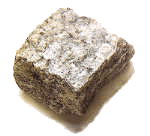Igneous Rocks

Granite
Igneous Rocks:
Igneous rocks (from the Greek word for fire) form from when hot, molten rock (magma) crystallizes and solidifies. The melt originates deep within the Earth near active plate boundaries or hot spots, then rises toward the surface. Igneous rocks are divided into two groups, intrusive or extrusive, depending upon where the molten rock solidifies.
Intrusive Igneous Rocks:
Intrusive, or plutonic igneous rock forms when magma is trapped deep inside the Earth. Great globs of molten rock rise toward the surface. Some of the magma may feed volcanoes on the Earth's surface, but most remains trapped below, where it cools very slowly until it solidifies. Slow cooling means the individual mineral grains have a very long time to grow, so they grow to a relatively large size. Intrusive rocks have a coarse grained texture.
Extrusive Igneous Rocks:
Extrusive, or volcanic, igneous rock is produced when magma exits and cools outside of, or very near the Earth's surface. These are the rocks that form at erupting volcanoes and oozing fissures. The magma, called lava when molten rock erupts on the surface, cools and solidifies almost instantly when it is exposed to the relatively cool temperature of the atmosphere. Quick cooling means that mineral crystals don't have much time to grow, so these rocks have a very fine-grained or even glassy texture. Hot gas bubbles are often trapped in the quenched lava, forming a bubbly, vesicular texture. Pumice, obsidian, and basalt are all extrusive igneous rocks.
Volcanic Eruptions:
When magma manages to migrate upward onto the surface, the result is volcanism (a volcanic eruption). A volcano forms as molten rock and solidified volcanic debris are ejected onto the surface and accumulate near the eruption site. In addition to rock material, large quantities of water vapor and gases are vented from volcanoes. When magma flows on the surface the material is called lava. The release of pressure during eruptions can produce ash clouds that may travel long distances.
Crystallization:
When magma cools in the subsurface it slowly forms rock through the process of crystallization. The chemical and physical reactions that take place in cooling magma result in the formation of interlocking mineral crystal grains (minerals such as quartz, feldspar, and mica). The mineral grains (crystals) are of a visible size, giving the rock a crystalline texture.
Igneous Rock Classifications:
Igneous rocks are classified by the geologic environment where they formed from the crystallization of molten material, and perhaps more importantly, by their mineral composition. Intrusive igneous rocks (like granite or gabbro) typically display visible mineral grains that are fairly easy to recognize with a little training. Extrusive rocks are more difficult to clearly identify because the mineral grains are typically invisible. However, the general composition of an extrusive rock is reflected by its color and density characteristics. General composition types include felsic (which is a mnemonic word derived from "feldspar" and "silica"), and mafic (which means rich in magnesium and iron, Fe). Felsic rocks tend to be light colored (white, pink, yellow), and are typically much less dense than mafic rocks that are typically dark (gray, brown, or black).
Mineral Composition:
Rhyolite (a felsic extrusive rock) has the same mineral composition as granite (an intrusive igneous rock) and is composed dominantly of the minerals potassium feldspar (K-spar), quartz, and lesser amounts of plagioclase feldspar, mica, hornblende, and other minerals. Likewise, basalt (a mafic extrusive rock) has the same mineral composition of the mafic intrusive rock, gabbro. This generalized composition of felsic and mafic can be subdivided into intermediate (between felsic and mafic composition), and ultramafic (rocks extremely enriched in magnesium and iron). Rocks of intermediate composition include diorite (intrusive) and andesite (the extrusive equivalent). Ultramafic rocks have special significance, in that they probably are derived from the mantle. They are relatively unstable on the Earth’s surface, and are typically metamorphosed. In nature and in simplistic interpretation, igneous rocks that make up most continental crust typically have a felsic composition (such as rhyolite and granite). The mafic rock basalt is the dominant rock type that makes up most ocean crust. Rocks of intermediate composition are derived from the mixing of continental and oceanic crust.
Batholiths and Other Plutons:
A body of rock formed from magma migrating and solidifying deep in the subsurface is called a pluton or an igneous intrusion. Huge intrusions, covering areas greater than one hundred square kilometers are called a batholith. Batholiths typically contain many separate intrusions that form over a relatively long period of time. Other types of intrusions typically form at shallower crustal depths; these include stocks,dikes,and sills. A stock is smaller than a batholith and typically represents the subsurface passage that fed molten material to a volcano or field of volcanoes over time. Sills and dikes are layers of igneous rock that typically form along fault zones, fractures, or between and parallel to sedimentary layers. A laccolith is a blister-shaped intrusion. Stocks, sills, dikes, laccoliths and other intrusions are remnants of past igneous activity and are exposed at the surface long after erosion has stripped away any ancient volcanoes and other overlying rocks and sediments that may have existed in an area.
Igneous Rocks and Minerals
- Andesite -- extrusive igneous rock
- Basalt -- extrusive igneous rock
- Dacite -- extrusive igneous rock
- Diabase -- fine-textured igneous rock
- Diorite -- intrusive igneous rock
- Gabbro -- intrusive igneous rock
- Granite -- intrusive igneous rock
- Granodiorite -- intrusive igneous rock
- Obsidian -- volcanic glass
- Olivine -- silicate mineral
- Pegmatite -- intrusive igneous rock
- Peridotite -- gem quality olivine
- Pumice -- light, porous, volcanic rock
- Rhyolite -- extrusive igneous rock
- Tuffs -- volcanic ash matrix
Source: U.S. Geological Survey
|


